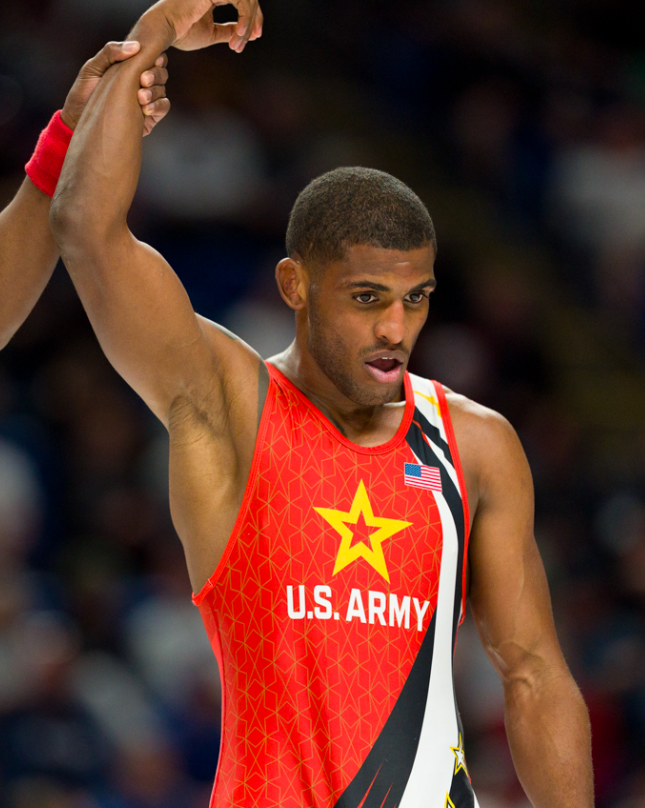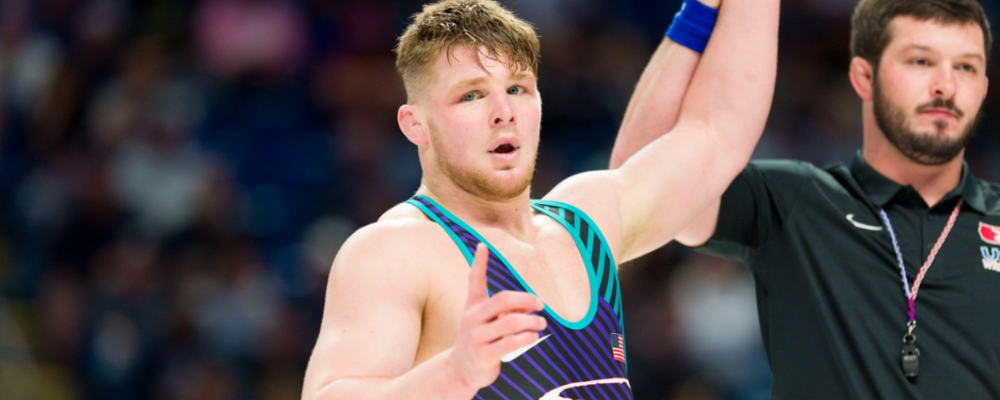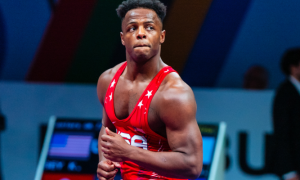STATE COLLEGE, PA — A new format and schedule, while initially confusing, could not hope to obscure the objective. Hardened and devoted men, of varying ages and from varying backgrounds, were in the arena to find out one thing: which of them would earn the right to represent the United States at the 2024 Paris Olympics. Whether under bright lights and in front of television cameras, or in an empty gymnasium in the middle of nowhere, the task is the task, the achievement is the achievement, and the significance of the matter would not, does not, and cannot change.
Though it does help to elevate the mood a little bit when fog machines, loud music, and announcers are involved.
The finals of the 2024 US Olympic Team Trials began at 6:30pm ET on Saturday from the Bryce Jordan Arena in State College, Pennsylvania and aired live on Peacock as well as the USA Network.
All six of Saturday’s tournament champions emerged with a career milestone (including three for a second time) by becoming members of the newly-minted USA Greco Olympic Team. While three of the six series winners from Saturday still do need to qualify their respective weight categories next month in Istanbul (at 60, 67, and 77 kg), for now they can take a pause and appreciate the payoff for which hard work and unique dedication are responsible.
With Kamal Bey (77 kg, Army/WCAP) having wrapped up his placement on the ’24 squad during Saturday’s first session by sweeping Aliaksandr Kikiniou (NYAC), the remainder of the bout card for Greco-Roman had become shortened by one series heading into Saturday evening. Bey’s substantial abilities would have certainly been appreciated by the primetime crowd, but his Greco brethren more than held the line in his absence from the evening lineup.
60 & 67 KG
On and on it goes. ’20 Olympian Ildar Hafizov (Army/WCAP) and two-time World Team member Dalton Roberts (Army/WCAP) have rested at the top of the 60 kg division in the US for almost two full Olympic cycles. Prior to Saturday morning, they had already met in four best-of-three Trials finals series, amassing over an hour of total match time between them. They had also become accustomed to requiring all three rounds of a series.
So, when Roberts took Match 1 (2-0) and Hafizov struck back in emphatic fashion for Match 2 (10-1), the fact that yet another third and decisive bout would be part of Saturday night’s program was hardly a surprise. This is how competitively-close they are. It is likewise indicative of their domestic dominance.
Match 3 opened with an invitation for both to clash and test one another positionally. They had done this so many times before that a feeling-out process was unnecessary. Just as the meter of their pace started to increase, Hafizov unfurled an arm throw that appeared good for correct hold points but the officials disagreed. Hafizov briefly wore a look of confusion until the reset. Back in the hand-fight they went with Roberts in on the wrists as Hafizov clamped a two-on-one. The referee decided that someone needed to go down in par terre and for them their man was Hafizov. Roberts locked a high gutwrench but nothing was doing. After the proceeding restart, a quick scramble for position gave way to Hafizov pursuing Roberts at the line en-route to a step-out point. An additional point was then tacked on as Roberts was penalized for a fleeing caution.
A 2-1 lead was Hafizov’s entering the second period. Roberts revved his engine just a touch more, plus there was the expectation that the passivities would flip in favor of Hafizov if not enough zeal was betrayed by either party. But — any such calls were pocketed when Roberts got behind Hafizov for a big takedown. Now ahead 3-2, the Northern Michigan alumnus pulled and pried at the arms, relegating Hafizov to try and force an action that would aid his own cause. The sledding was rough, for both wrestlers, and Roberts specializes in that kind of match. When the dust settled on their fifth thrilling best-of-three showdown, it was Roberts who had earned one more grueling victory in conjunction with the privilege of donning the stars and stripes as a potential Olympian for the first time in his career.
Coleman Reclaims Top Spot
Not too long ago, it was a familiar sight. Alex Sancho (67 kg, Army/WCAP) and Ellis Coleman (Army/WCAP) were regularly battling one another in high-leverage scenarios, including in two straight Trials finals back in ’17 and ’18. Their most recent series prior to this weekend had occurred in ’21 to select the Tokyo Olympic Team. It was in Fort Worth, Texas just over three years ago when Sancho had handed Coleman his first best-of-three loss involving the pair. On Saturday morning, they started it all up again. Sancho edged Coleman via criteria 1-1, and Coleman bounced back with a 2-0 decision to force a third and decisive round.
Sancho, who often operates by settling into a rhythm, got moving quickly as Match 3 got underway. Coleman was keen to meet him on even ground and his footwork incited appropriate playback. But rather than resolve himself to wading through the pummel, Sancho dragged behind Coleman to score a step-out plus one extra from a fleeing caution. A reset, and both wrestlers wanted to up the pace. Although they may differ stylistically, Sancho and Coleman have similar tactics when it comes to angling for handles in the tie-ups. While interesting to watch, this commonality by and large extinguishes wide-open attack lanes, which was the case in this contest as the first period drew to a close.

Just prior to the halfway mark of the second, Sancho was dinged for passivity and Coleman did not let the opportunity go to waste. The whistle blew and without hesitation he sought an amenable lock. Following a slight adjustment, he cranked and extended his legs, much like a modified crash gutwrench. The force from the maneuver was enough for Coleman to rotate the hold and expose Sancho once for two points. This meant a sprint for Sancho, who was suddenly trailing 3-2. He was active in the zone and driving the kind of pressure that had many times previously resulted in late-match scores. A deep underhook, and then another, were deployed; but Coleman’s motion was so crisp and his instincts so sharp that the relationship between his legs and hands allowed him to thwart any possible problematic advances without bailing position. Sancho gave it all he could, down to the last ounce, but Coleman kept upright through the remainder to earn his second spot on a US Olympic Team, this time by a final score of 3-2.
87 & 97 KG
On Saturday morning, ’22 U20/’23 U23 World roster member Payton Jacobson (87 kg, Sunkist/NTS) continued his mesmerizing performance at the Olympic Trials by coming away with several impressive scores against two-time World Team rep Spencer Woods (Army/WCAP) to earn an 8-2 victory in Match 1. Between the morning session and Saturday evening’s bout card, the question was how Woods might respond and adjust to the intensity, timing, and skill his younger foe brings to the table.
In Match 2, he responded by displaying more conviction and urgency, which was indeed necessary given the manner in which Jacobson attacked the tie-ups. They fought and exchanged tiny doses of counter-pressure, and both had their feet eating up ground. Woods was put down in passivity first, and Jacobson worked for a lock but could not garner a turn. Back standing and the pummeling was tight, with only fleeting breakaways. Woods’ posture was effective, even if it were not deterring Jacobson’s jack-hammering approach.
An arm throw try from Jacobson early in the second period kept Woods sharp as they resumed pouring into the hand-fight. The passives were almost guaranteed to flip, and they did. Down 1-0, Woods changed the complexion of the contest by achieving his preferred reverse lock and putting Jacobson head over heels for four points. Back standing, and Jacobson appeared undaunted as he pursued Woods near the edge before scoring a step-out. The board read 5-2 in Woods’ favor. Jacobson did not stop hustling for actionable positions but those windows closed as soon as they opened. Thus, Woods stood tall till the whistle to even the series and set up a suspenseful third match.
Woods bore a stone-faced expression as he walked up and onto the platform for the tie-breaking battle. This was business, but it was also personal, for he had been the one who qualified the weight class for Team USA at the Olympics. He received a bye to Saturday’s finale for that accomplishment and wanted to finish what he started nearly two months ago. Jacobson, by contrast, was loose upon strolling down the aisle. The 22-year-old did not lack for confidence all tournament long, and match-by-match he had grown increasingly emboldened.
A staccato screech signaled the beginning of Match 3 and the pair clashed in earnest. Woods, who has a good couple of inches on Jacobson, hawked over in the pummel but minded improved positioning, whereas Jacobson did not require the same type of adjustment. He was quick to latch hard onto Woods’ arms to push, pull, and influence where each exchange took place. The speed in which they were testing one another provided the most comprehensive picture of how legitimate Greco-Roman wrestling should always be presented.
When passivity became a factor in the first period, Woods was selected to hit the deck. Jacobson’s gutwrench has become a reliable weapon of late, and he crunched Woods around the midsection to net two exposure points for a 3-0 lead. Woods’ output did not require improvement heading into Period 2 and he feverishly worked to open up the body for exploitable lanes. Thing was, Jacobson’s own sense of urgency had not diminished. He was just as active and intentional — though in second periods for wrestlers holding a lead, sustaining a hard pace often does little to ward off a being called passive. This accepted guideline with regards to passivity provided Woods with his best chance to score in the second period. “The Alaskan Assassin” once again wrangled a reverse lock — and Jacobson smartly reached his feet to break apart the attempt. Time was not on Woods’ side when they reset in the center. Jacobson resumed competing as if behind on points and was rewarded with a late chance from top par terre. An unusual call since such opportunities are designed for athletes who are trailing. Jacobson assumed his lock but did not receive a lot of time to work and they reset for the race to the finish. Resolved to last-gasp attempts, Woods was relentless in his drive to score before time expired. But as it had been since wrestling began on Friday morning, Jacobson’s nonstop motor and will to win were too much to overcome.
The match was over. So was the series. And now for the first time since ’08, when a young Spenser Thomas Mango took the mat in Beijing, the program at Northern Michigan University have for themselves a United States Greco-Roman Olympian.
Rau Reaches Olympics
Par terre is how Alan Vera (97 kg, NYAC) earned the points necessary to both defeat Joe Rau (TMWC) in the opening round and create a little distance between them on the scoreboard. Vera walked away a 7-1 winner on Saturday morning, and therefore it was up to Rau to figure out how to not only defend, but also to open up his own scoring opportunities on the feet and elsewhere.
Rau did not need to defend in Match 2. He was in command the entire time.
By sticking to a steady diet of short snaps and hustling work in the ties, Rau was the recipient of the bout’s first passivity/par terre chance. He opted for a front headlock, but Vera hastily found his feet and a reset was ordered. Later in the frame, Rau zipped in off of an arm drag to get behind and body Vera to the mat for a takedown, allowing the Chicago native to walk into the break up 3-0.
The onus was on Vera to up his workload so that the next passive call would be his. Perhaps due to holding a firm grasp of the current rule-set’s machinations, Rau aggressively checked into the pummel and was soon able to latch a head-and-arm hold that further put the tempo under his control. And when Vera broke free, Rau efforted with underhooks in search of scoring attacks. Passivity then rang again on Vera. Rau this time settled on a high-gut-lift; Vera seemed to defend but was quickly cited for a leg foul. Two more points went to Rau and his lead had expanded to 6-0. Another high-gut attempt from Rau gave way to a front headlock, though no points came from the hold. Upon standing, Rau kept with the same protocol and collected the 6-0 decision victory, as well as his first career win over Vera in four tries.
Soon into Match 3, Vera showed something different by attempting a throw. It was ruled a slip but Rau covered on instinct. Another interesting tactic was on the part of Rau. In Match 2, he had used a head-arm hold to compel a Vera opening, or simply as a means of control. Such a hold can be used as a setup, to wear down an opponent, or simply to rest. Whatever Rau’s motives were with the head-arm, the tie helped him to gauge his position immediately after Vera broke free, which then resulted in Rau sliding in a deep left underhook. They jousted some more and in an instant Rau was behind Vera to score a takedown that was followed in short order by a gutwrench. Down 4-0, Vera attempted a headlock after the next restart. Rau saw it coming and snuffed it out for two more points.
The board read 6-0 and plenty of time was left in the match for Vera to cut into what was by then a sizable deficit. Considering his ability to pile up points in bunches, it might not even take him very long. That is how dangerous Vera is offensively.
Rau could not let that happen.
So he didn’t.
Brandishing a combination of strength, will, and determination to which normal folks cannot relate, Rau marched right back into the center and returned to peppering his foe in the trenches. A right underhook stopping midway up Vera’s back served as a reminder of the Chicagoan’s renewed conviction. He was not going to yield so much as a centimeter if he could help it. Vera, needing to generate momentum, hawked inside to kickoff an attack. Rau owned the leverage and found himself chest-to-back on top of Vera before spinning behind for two. The match had become a memory. So too did the series.
Rau did not jump up for joy. Instead, he immediately embraced Vera while kneeling and the two shared some words. The former Cuban National wrestler — who unfailingly exudes care and class, and is a credit to this sport as well as to his adopted country — raised Rau’s arm to the crowd as they both climbed to their feet. Vera had sympathized with Rau’s previous plights and, though himself now disappointed, could not hide his natural kindness, nor his respect, for what Rau had endured.
Heartache, anger, regret, and bewilderment no longer owned a resting spot on Rau’s shoulders. Any remnants of previous emotional burdens were now replaced by the realization of a dream for which he had long suffered, and in numerous ways, and in ways only few might ever fully understand.
That chapter in Rau’s wrestling life is now closed. However the next one starts, the first line will include “2024 Olympian”.
130 kg: Coon Edges Schultz
The recent pattern of Cohlton Schultz (130 kg, Sunkist) doing his best to control ’18 World silver Adam Coon (NYAC/Cliff Keen WC) in the ties and capitalize whenever possible — be it from step-outs, scrambles, and anything else — went unaltered in Match 1. Schultz owned a 3-0 lead after the first period and eventually had his hand raised following a 3-1 decision. For Coon to make this a series, more assertion in the ties along with finding a way to stymie Schultz in transitional situations appeared to be the most pertinent items.
Said assertion in the ties was in Schultz’s department as the match began in the form of a two-on-one to Coon’s left arm. They went static from the position but a gesture did not come from the mat official until Coon heeled towards the zone. From top par terre, Schultz looked for a gutwrench and Coon could not be budged. They returned standing and more snug ties ensued as Schultz carried a 1-0 lead entering intermission.
Schultz plowed ahead to start the second period and diligently went back to work on the two-on-one, though Coon held his ground a little more before action stalled. Criteria was his as time began to dwindle. The referee then determined that a third par terre was appropriate. Schultz benefited from the call and acquired his lock but, again, Coon stayed put and eventually carried his criteria edge to the finish line, thus knotting the series at one apiece.
Schultz did not wait to fire up the footwork in Match 3 and rammed towards Coon as if to send a message. One of the three-time age-group World medalist’s calling cards has been his “big push”, and aside from a toned-down version in the opener, said push had largely been absent. A tool aimed as much at catalyzing step-out points as it is intimidation, no one can argue its effectiveness. However, it was unsuccessful in the third bout. Schultz plowed forth with a purpose — and Coon played matador to the bull. Schultz was the one who stepped out of bounds and Coon had snagged a 1-0 lead. They went back to a more measured brand of hand-fighting and Schultz found his two-on-one while Coon finagled around in the ties. The referee was hand-waving for a passivity call that would soon be levied on Schultz. From top par terre, Coon delivered the most clutch moment against his main rival since ’21. After settling his lock for a more comfortable and confident attempt, he was able to exert enough force for one rotation to expand his margin to 4-1.
4-1 is by no means an insurmountable deficit, particularly in Greco-Roman. And at still only 23 years of age, Schultz has displayed time and again a knack for coming up with point-scoring sequences when they are needed the most. Coon had done well to neutralize Schultz’s more natural advantages in the pummel so it would come down to passivity. Sure enough, the officials confirmed the second-period call against Coon, thus clearing the way for Schultz to do damage from top. At the whistle, he circled around for a front headlock. Coon fought the grip for a few instants, doing his best to not capitulate. He then reached his feet as the hold ceased to become a threat. That alone steered the tide firmly in the former Wolverine’s favor — but just as the soles of Coon’s shoes made solid contact with the mat, Schultz’s balance was compromised and he dropped to his stomach. Coon hurriedly covered for a startling two additional points. His lead had gone from 4-1 to 6-1. Schultz urgently clawed at the hands upon the reset in an effort to, somehow, some way, ignite a series-changing scoring sequence. It wouldn’t happen. On this night, it couldn’t. Time had run out. Coon had summited the mountaintop once again, with the exception that this victory came attached to a trip to the Olympics.
Coon, 29, originally wrested control of the 130 kg division in ’18 and later that year earned silver at the World Championships. The next season, Schultz won the World Team Trials Challenge Tournament and met Coon at Final X: Lincoln, which marked the dawn of their rivalry. Coon won that series 2-0, and repeated as the victor over Schultz in the ’20 Olympic Trials (held in April of ’21). After Coon was unable to qualify 130 for the Tokyo Olympics, he signed a contract with the National Football League’s Tennessee Titans but an injury cut short his time on that team. He would later sign with the Seattle Sea Dragons of the XFL and soon exited football in advance of returning to Greco-Roman.
Over the course of Coon’s two-year absence from competition, Schultz overtook the #1 spot and made consecutive World Teams (’21 and ’22). Coon was back for the ’23 US Open and was soundly defeated by Schultz, to whom he would eventually fall three more times, including at Final X: Newark and in the December National final. Coon spent a substantial amount of time preparing overseas this past winter and made several adjustments to his training plan that he had hoped would make an impact leading up to the Olympic Trials. His efforts were clearly visible on Saturday. And as a prior World medalist, Coon will certainly be considered a strong contender for a medal once the heavyweight division at the Paris Olympiad is contested on August 5-6.
2024 Olympic Trials Notes
- All three of the wrestlers who qualified their weight categories on behalf of the US at the Pan-American Olympic Qualifier (Woods — 87 kg, Vera — 97 kg, and Schultz — 130 kg) on February 28 enjoyed byes to the best-of-three final — and all three were defeated by their challengers (Jacobson, Rau, and Coon, respectively).
- All three series in the qualified weight categories necessitated a third round.
- Only one series ended in two matches — Bey over Kikiniou at 77 kg.
- In the series for 67, 97, and 130 kg, the winners (Coleman, Rau, and Coon) had dropped their first matches before prevailing in the next two.
- Coleman, Rau, and Coon were the only champions from Saturday to have won the Olympic Trials for a second time (Coleman, ’12; Rau, ’16, Coon, ’21).
- Just two matches out of the six best-of-three finals series were won by technical fall (Bey over Kikiniou in Match 1; Rau over Vera in Match 3).
- The winners from Saturday’s final in the weight classes of 60, 67, and 77 kg (Roberts, Coleman, and Bey) will compete at the World Olympic Games Qualifier on May 5 in Istanbul, Turkey. Athletes at the World OG Qualifier must place in the top-3 of their weight divisions in order to earn Olympic berths for their countries.
- Additional Olympic Team Trials coverage is incoming, including quotes from tournament champions, athlete biographies, and more.
2024 US Olympic Trials
April 19-20 — State College, PA
BEST-OF-THREE FINALS
60 kg
Ildar Hafizov (Army/WCAP) vs. Dalton Roberts (Army/WCAP)
Roberts def. Hafizov two matches to one
Match 1: Roberts def. Hafizov 2-0
Match 2: Hafizov def. Roberts 10-1, TF
Match 3: Roberts def. Hafizov 3-2
67 kg
Alex Sancho (Army/WCAP) vs. Ellis Coleman (Army/WCAP)
Coleman def. Sancho two matches to one
Match 1: Sancho def. Coleman 1-1 (criteria)
Match 2: Coleman def. Sancho 2-0
Match 3: Coleman def. Sancho 3-2
77 kg
Kamal Bey (Army/WCAP) def. Aliaksandr Kikiniou (NYAC)
Bey def. Kikiniou two matches to zero
Match 1: Bey def. Kikiniou 9-1, TF
Match 2: Bey def. Kikiniou 6-1
87 kg
Spencer Woods (Army/WCAP) vs. Payton Jacobson (Sunkist/NTS)
Jacobson def. Woods two matches to one
Match 1: Jacobson def. Woods 8-2
Match 2: Woods def. Jacobson 5-2
Match 3: Jacobson def. Woods 3-1
97 kg
Alan Vera (NYAC) vs. Joe Rau (TMWC)
Rau def. Vera two matches to one
Match 1: Vera def. Rau 7-1
Match 2: Rau def. Vera 6-0
Match 3: Rau def. Vera 8-0, TF
130 kg
Cohlton Schultz (Sunkist) vs. Adam Coon (NYAC/Cliff Keen WC)
Coon def. Schultz two matches to one
Match 1: Schultz def. Coon 3-1
Match 2: Coon def. Schultz 1-1 (criteria)
Match 3: Coon def. Schultz 6-1

Listen to “5PM57: Kamal Bey and David Stepanyan” on Spreaker.
Listen to “5PM56: Rich Carlson and Spencer Woods” on Spreaker.
SUBSCRIBE TO THE FIVE POINT MOVE PODCAST
iTunes | Stitcher | Spreaker | Google Play Music

Notice: Trying to get property 'term_id' of non-object in /home/fivepointwp/webapps/fivepointwp/wp-content/themes/flex-mag/functions.php on line 999
















